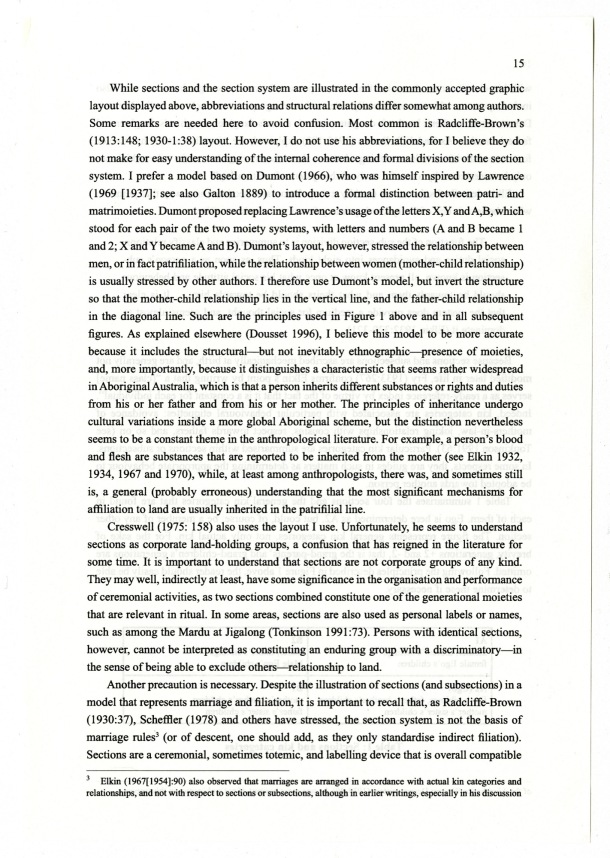|
| 
[Note: this transcription was produced by an automatic OCR engine]
15
While sections and the section system are illustrated in the commonly accepted graphic
layout displayed above, abbreviations and structural relations differ somewhat among authors.
Some remarks are needed here to avoid confusion. Most common is Radcliffe-Brown’s
19l3:l48; 1930-1:38 layout. However, I do not use his abbreviations, for I believe they do
not make for easy understanding of the internal coherence and formal divisions of the section
system. I prefer a model based on Dumont 1966, who was himself inspired by Lawrence
1969 [1937]; see also Galton 1889 to introduce a fomral distinction between patri- and
matrimoieties. Dumont proposed replacing Lawrence’s usage of the letters X,Y andA,B, which
stood for each pair of the two moiety systems, with letters and numbers A and B became 1
and 2; X and Y became A and B. Dumont’s layout, however, stressed the relationship between
men, or in fact patrifiliation, while the relationship between women mother—chi]d relationship
is usually stressed by other authors. I therefore use Dumont’s model, but invert the structure
so that the mother-child relationship lies in the vertical line, and the father-child relationship
in the diagonal line. Such are the principles used in Figure 1 above and in all subsequent
figures. As explained elsewhere Dousset 1996, I believe this model to be more accurate
because it includes the structural—but not inevitably ethnographic—presence of moieties,
and, more importantly, because it distinguishes a characteristic that seems rather widespread
in Aboriginal Australia, which is that a person inherits difierent substances or rights and duties
from his or her father and from his or her mother. The principles of inheritance undergo
cultural variations inside a more global Aboriginal scheme, but the distinction nevertheless
seems to be a constant theme in the anthropological literature. For example, a person’s blood
and flesh are substances that are reported to be inherited from the mother see Elkin 1932,
1934, 1967 and 1970, while, at least among anthropologists, there was, and sometimes still
is, a general probably erroneous understanding that the most significant mechanisms for
affiliation to land are usually inherited in the patrifilial line.
Cresswell 1975: 158 also uses the layout I use. Unfortunately, he seems to understand
sections as corporate land—holding groups, a confusion that has reigned in the literature for
some time. It is important to understand that sections are not corporate groups of any kind.
They may well, indirectly at least, have some significance in the organisation and performance
of ceremonial activities, as two sections combined constitute one of the generational moieties
that are relevant in ritual. In some areas, sections are also used as personal labels or names,
such as among the Mardu at Jigalong Tonkinson 1991273. Persons with identical sections,
however, cannot be interpreted as constituting an enduring group with a discriminatory—in
the sense of being able to exclude others—relationship to land.
Another precaution is necessary. Despite the illustration of sections and subsections in a
model that represents marriage and filiation, it is important to recall that, as Radclifle-Brown
l930:37, Scheflier 1978 and others have stressed, the section system is not the basis of
marriage nrles3 or of descent, one should add, as they only standardise indirect filiation.
Sections are a ceremonial, sometimes totemic, and labelling device that is overall compatible
3 Elkin l967[1954]:90 also observed that marriages are amrnged in accordance with actual kin categories and
relationships, and not with respect to sections or subsections, although in earlier writings, especially in his discussion
|